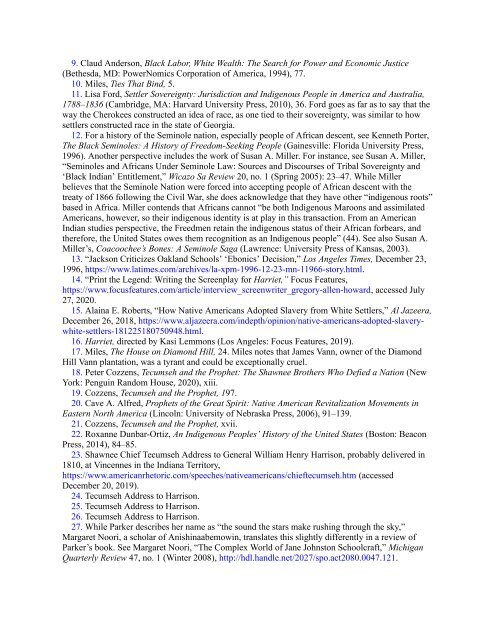You also want an ePaper? Increase the reach of your titles
YUMPU automatically turns print PDFs into web optimized ePapers that Google loves.
9. Claud <strong>An</strong>derson, Black Labor, White Wealth: The Search for Power and Economic Justice<br />
(Be<strong>the</strong>sda, MD: PowerNomics Corporation <strong>of</strong> America, 1994), 77.<br />
10. Miles, Ties That Bind, 5.<br />
11. Lisa Ford, Settler Sovereignty: Jurisdiction and <strong>Indigenous</strong> People in America and Australia,<br />
1788–1836 (Cambridge, MA: Harvard University Press, 2010), 36. Ford goes as far as to say that <strong>the</strong><br />
way <strong>the</strong> Cherokees constructed an idea <strong>of</strong> race, as one tied to <strong>the</strong>ir sovereignty, was similar to how<br />
settlers constructed race in <strong>the</strong> state <strong>of</strong> Georgia.<br />
12. For a history <strong>of</strong> <strong>the</strong> Seminole nation, especially people <strong>of</strong> African descent, see Kenneth Porter,<br />
The Black Seminoles: A <strong>History</strong> <strong>of</strong> Freedom-Seeking People (Gainesville: Florida University Press,<br />
1996). <strong>An</strong>o<strong>the</strong>r perspective includes <strong>the</strong> work <strong>of</strong> Susan A. Miller. For instance, see Susan A. Miller,<br />
“Seminoles and Africans Under Seminole Law: Sources and Discourses <strong>of</strong> Tribal Sovereignty and<br />
‘Black Indian’ Entitlement,” Wicazo Sa Review 20, no. 1 (Spring 2005): 23–47. While Miller<br />
believes that <strong>the</strong> Seminole Nation were forced into accepting people <strong>of</strong> African descent with <strong>the</strong><br />
treaty <strong>of</strong> 1866 following <strong>the</strong> Civil War, she does acknowledge that <strong>the</strong>y have o<strong>the</strong>r “indigenous roots”<br />
based in Africa. Miller contends that Africans cannot “be both <strong>Indigenous</strong> Maroons and assimilated<br />
Americans, however, so <strong>the</strong>ir indigenous identity is at play in this transaction. From an American<br />
Indian studies perspective, <strong>the</strong> Freedmen retain <strong>the</strong> indigenous status <strong>of</strong> <strong>the</strong>ir African forbears, and<br />
<strong>the</strong>refore, <strong>the</strong> <strong>United</strong> <strong>States</strong> owes <strong>the</strong>m recognition as an <strong>Indigenous</strong> people” (44). See also Susan A.<br />
Miller’s, Coacoochee’s Bones: A Seminole Saga (Lawrence: University Press <strong>of</strong> Kansas, 2003).<br />
13. “Jackson Criticizes Oakland Schools’ ‘Ebonics’ Decision,” Los <strong>An</strong>geles Times, December 23,<br />
1996, https://www.latimes.com/archives/la-xpm-1996-12-23-mn-11966-story.html.<br />
14. “Print <strong>the</strong> Legend: Writing <strong>the</strong> Screenplay for Harriet,” Focus Features,<br />
https://www.focusfeatures.com/article/interview_screenwriter_gregory-allen-howard, accessed July<br />
27, 2020.<br />
15. Alaina E. Roberts, “How Native Americans Adopted Slavery from White Settlers,” Al Jazeera,<br />
December 26, 2018, https://www.aljazeera.com/indepth/opinion/native-americans-adopted-slaverywhite-settlers-181225180750948.html.<br />
16. Harriet, directed by Kasi Lemmons (Los <strong>An</strong>geles: Focus Features, 2019).<br />
17. Miles, The House on Diamond Hill, 24. Miles notes that James Vann, owner <strong>of</strong> <strong>the</strong> Diamond<br />
Hill Vann plantation, was a tyrant and could be exceptionally cruel.<br />
18. Peter Cozzens, Tecumseh and <strong>the</strong> Prophet: The Shawnee Bro<strong>the</strong>rs Who Defied a Nation (New<br />
York: Penguin Random House, 2020), xiii.<br />
19. Cozzens, Tecumseh and <strong>the</strong> Prophet, 197.<br />
20. Cave A. Alfred, Prophets <strong>of</strong> <strong>the</strong> Great Spirit: Native American Revitalization Movements in<br />
Eastern North America (Lincoln: University <strong>of</strong> Nebraska Press, 2006), 91–139.<br />
21. Cozzens, Tecumseh and <strong>the</strong> Prophet, xvii.<br />
22. Roxanne Dunbar-Ortiz, <strong>An</strong> <strong>Indigenous</strong> Peoples’ <strong>History</strong> <strong>of</strong> <strong>the</strong> <strong>United</strong> <strong>States</strong> (Boston: Beacon<br />
Press, 2014), 84–85.<br />
23. Shawnee Chief Tecumseh Address to General William Henry Harrison, probably delivered in<br />
1810, at Vincennes in <strong>the</strong> Indiana Territory,<br />
https://www.americanrhetoric.com/speeches/nativeamericans/chieftecumseh.htm (accessed<br />
December 20, 2019).<br />
24. Tecumseh Address to Harrison.<br />
25. Tecumseh Address to Harrison.<br />
26. Tecumseh Address to Harrison.<br />
27. While Parker describes her name as “<strong>the</strong> sound <strong>the</strong> stars make rushing through <strong>the</strong> sky,”<br />
Margaret Noori, a scholar <strong>of</strong> <strong>An</strong>ishinaabemowin, translates this slightly differently in a review <strong>of</strong><br />
Parker’s book. See Margaret Noori, “The Complex World <strong>of</strong> Jane Johnston Schoolcraft,” Michigan<br />
Quarterly Review 47, no. 1 (Winter 2008), http://hdl.handle.net/2027/spo.act2080.0047.121.


















